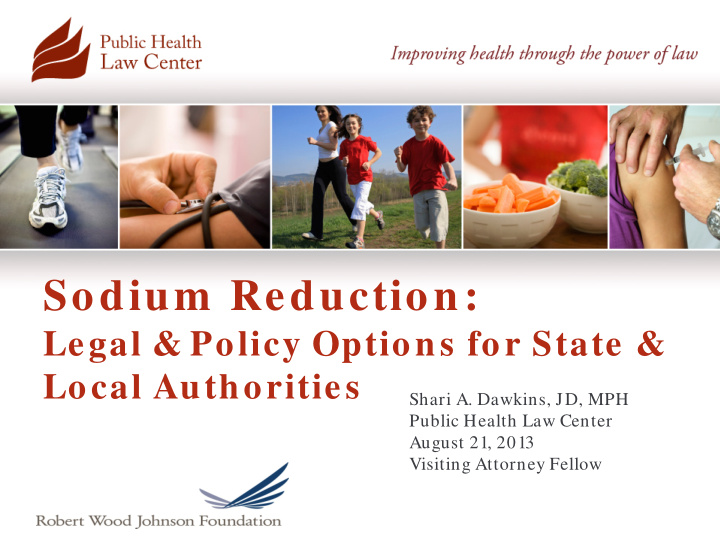



Sodium Reduction: Legal & Policy Options for State & Local Authorities Shari A. Dawkins, JD, MPH Public Health Law Center August 21, 2013 Visiting Attorney Fellow
Overview Sodium Consumption as a public health issue Health Impact Healthcare Costs Use of law & policy in reducing sodium consumption Federal State & Local Challenges to State & Local options Next Steps Conclusion
THE PUBLIC HEALTH ISSUE
Why is Salt Im portant? NaCl = Essential= 40% Sodium 500 mg/ day 60% Chloride SALT The source of 90% of the Inexpensive sodium in food supply Multipurpose
Where is sodium found? 5% 6% Processed & Restaurant 12% Naturally Occurring Added while eating 77% Added during home cooking Source: Mattes, RD. Journal of American College Nutrition, 1991, 10:383-393.
Am erican Heart Association’s “Salty Six”
Intake Levels 4,000 3,500 3,400 mg Sodium in m g/ day 3,000 2,500 2,000 2,300 mg General 2,000 mg Adult pop 1,500 1,500 mg 1,500 mg 1,000 At-risk populations 500 0 USDA USDA WHO AHA ACTUAL Recom m endation
Public Health Concern Health Im pact Healthcare Costs Immediate decrease in Hypertension intake to 2300mg may save ≈68 million adults (1 in 3) $18 billion in health care Cardiovascular Disease costs annually & Stroke Gradual decrease by 40% ≈800,000 adult deaths over 10yrs would save ≈500,000 lives per year Decrease by 400mg/ day Stomach Cancer would save $7 billion MS annually
LAW & POLICY AT FEDERAL LEVEL
IOM Recommendations 2010 IOM Report- Strategies to Reduce Sodium Intake in the U.S. Primary Modify GRAS status of Salt Interim Voluntary collaborations Revisions to Supporting labeling, sodium claims, Daily Value levels
Primary- Modify GRAS “FDA should modify the generally recognized as safe (GRAS) status of salt added to processed foods in order to reduce the salt content of the food supply in a stepwise manner.”
WHY GRAS? Nothing can be added to food until it has been approved for safety by the FDA, unless the substance is “generally recognized as safe” better known as “GRAS.” The FDA considers salt’s use as a: “common food ingredient” to be “Generally Recognized as Safe” (GRAS) without any special conditions. There are no legal limits on how much salt can be added to food, as long as within “good manufacturing practices”(reasonable limit for desired taste/ or purpose) Modifying the GRAS status of salt will create limits on the amount of sodium used in food production
Interim - Voluntary Industry- Led Governm ent- Led Children’s Food & National Salt Beverage Advertising Reduction Initiative Initiative (CFBAI) (NSRI) National Restaurant Interagency Working Association Kids Group (IWG) LiveWell CDC Sodium Individual Companies Reduction in Communities Program Subway
Supporting- FDA • Improve effectiveness of Nutrition the Nutrition Facts Panel through front of package Labeling labeling • Expand regulations under Menu the Nutrition Labeling Labeling/ Education Act of 1990 (NLEA) to cover sodium Sodium content claims on menu claims items • Considering lowering Daily from 2,400mg to 2,300mg or 1,500mg Value recommendations
Supporting- USDA USDA School Breakfast USDA School Lunch Program Program National School National School Breakfast Program Lunch Program Guidelines Guidelines 25%-27% reduction in 53%-54% reduction in sodium content in breakfast sodium content, from meals, from 2004-‘05 2004-‘05 baseline baseline numbers numbers 3-step reduction (2, 5, and 10 3-step reduction (2, 5, and 10 yrs from July 1, 2012) yrs from July 1, 2012) Final limits range from ≤ Final limits range from ≤ 430 - ≤ 500 mg/meal 640 - ≤ 740 mg/meal
LAW & POLICY AT THE STATE & LOCAL LEVELS
State & Local Options Menu labeling Warning labels Sodium Licensing Requirement Procurement policies Reduction Licensing/ Taxing Voluntary Initiatives
Labeling Menu Labeling Warning Labels Disclosure of sodium Under NLEA, state & local content on menus & menu authorities can mandate boards warnings relating to safety of the food or components NLEA does not preempt of food. establishments < 20 national outlets Ex: High sodium content on menus or shelves FDA Waiver Philadelphia sodium content on menus
Procurem ent, Licensing, Taxing Procurem ent Licensing/ Taxing Gov. use of purchasing Inclusion of a sodium power to reduce sodium reduction requirement MA Dept of Public Health as part of licensing Nutritional policies for purchased and prepared standards foods for all state agencies Higher sales tax on NYC Nutrition Purchasing Criteria high sodium meals and 2008 individual foods & individual items meals 2009 beverages 2011 vending machines
Voluntary Initiatives 90+ State & Local authorities and health organizations as partners in NSRI Shawnee County Department of Health as recipient of CDC Sodium Reduction in Communities program set goal to reduce sodium in concessions at Topeka County Zoo by 25% Shawnee County provided convenience stores with low sodium items and increased access to fresh fruit and produce NYC Dept of Health & Mental Hygiene recently launched a media campaign “Compare labels, Choose less Sodium” on city subways urging consumers to make better choices
CHALLENGES TO STATE & LOCAL OPTIONS
Challenges
International Exam ples United Kingdom Coordinated voluntary national effort to reduce sodium intake by 20% with voluntary collaborations by government and industry 20% decrease in intake announced last summer- current national daily intake amount is 3,240 mg Finland Requires high salt warnings on foods exceeding certain amounts of sodium in specific categories Currently one of the lowest national sodium intake amounts of 3,000 mg/ day
Next Steps Educate Collaborate Regulate
Government & Policy Makers Researchers Food Industry and manufacturers & preparers Academia Health Consumers Professionals
Conclusion • Sodium intake is still too high given all recommended amounts • Voluntary efforts alone will not bring Sodium levels down- need regulations • Opportunity for great health impact exists at state & local levels
THANK YOU!
QUESTIONS?
Recommend
More recommend